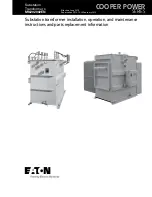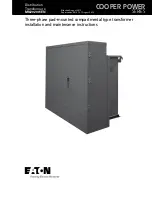
10
Overview
There are two steps to connecting the current transformers: pass the wire to be measured through the CT
and connect the CT to the WattNode. Note: always remove power before disconnecting any live wires.
Split-core CTs may be mounted around a wire by opening one side of the CT, sliding the CT around the
wire, and then closing the open side of the CT. A split-core CT is opened by pulling the removable section
straight away from the rest of the CT; this may require a strong pull. To reinstall the removable portion of
the CT, check that the ends mate correctly by looking at the exposed laminated steel core on the CT body
and the removable section. When pressing the CT back together, if it seems to jam and will not close, the
steel core pieces are probably not aligned correctly. Do not force the CT, instead, reposition or rock the
removable portion until the CT closes without excessive force. After a split-core CT has been placed
around a wire, a nylon cable tie should be secured around the CT to prevent inadvertent opening.
The WattNode does not measure negative power and will instead indicate zero power. CTs are directional
and if mounted backwards or with their wires reversed the power will be negative. In an installation with
just one CT, the WattNode would output zero power. In a multiple CT installation, if one CT were
backwards and others were mounted correctly, then the reversed CT would cause the power on that phase
to be subtracted from the power measured on the other phases, resulting in a plausible, but incorrect
reading.
CTs are labeled with either a label which says “THIS SIDE TOWARD SOURCE”, or with an arrow.
Mount the CT so the label faces or the arrow points towards the current source—typically the circuit
breaker for the circuit being measured or the utility’s meter box. It is also possible to measure generated
power by treating the generator as the source.
Start by removing power from wires being measured. Toroidal CTs require that the wire be disconnected
before passing it through the opening in the CT. Put the line wires through the CTs as shown in the section
Measurement Configurations
.
Next, connect the CTs to the WattNode. The CT inputs to the WattNode are sensitive to ESD (electrostatic
discharge), so you should ground yourself by touching the service panel case or some other grounded metal
object before connecting the CTs to the WattNode. Route the twisted black and white wires from the CT to
the WattNode. Any excess length may be trimmed from the wires if desired. Strip or trim the wires to
expose 1/4" (6 mm) of bare wire. Do not leave more than 5/16" (8 mm) or less than 3/16" (5 mm) of bare
wire. The current transformers connect to the black screw terminal block, and it may be easier to install the
terminal block on the WattNode before connecting the wires from the CTs. Connect each CT, with the
white wire aligned with the white dot on the label, and the black wire aligned with the black dot. Note the
order in which the phases are connected, as the voltage phases
must
match the current phases for accurate
power measurement. Any unused CT inputs must be shorted. You may trim short sections off the end of
the CT wires to use as jumpers. Be careful to leave insulation on the exposed portion of the jumper(s) to
prevent shock or shorting danger.
Finally record the CT full-scale current as part of the installation record for each WattNode. If the wires
being measured are passed through the CT(s) more than once, then the recorded full-scale CT current is
divided by the number of times that the wire passes through the CT.
Connecting Voltage Terminals
Always disconnect power
—by shutting off circuit breaker(s) or removing fuse(s)—before connecting the
voltage lines to the WattNode.
The WattNode must be connected to voltage lines which are protected
by fuses or circuit breakers.
Connect each voltage phase input to a circuit breaker on the required phase.
If there is more than one circuit breaker on a phase, then any one of the circuit breakers may be used.
When installing multiple WattNodes at the same site, it may be easier to provide separate circuit breaker(s)
for the WattNodes.






































